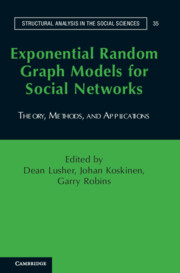Book contents
- Frontmatter
- Contents
- List of Figures
- List of Tables
- 1 Introduction
- Section I Rationale
- 2 What Are Exponential Random Graph Models?
- 3 Formation of Social Network Structure
- 4 Simplified Account of an Exponential Random Graph Model as a Statistical Model
- 5 Example Exponential Random Graph Model Analysis
- Section II Methods
- Section III Applications
- Section IV Future
- References
- Index
- Name Index
4 - Simplified Account of an Exponential Random Graph Model as a Statistical Model
Published online by Cambridge University Press: 05 April 2013
- Frontmatter
- Contents
- List of Figures
- List of Tables
- 1 Introduction
- Section I Rationale
- 2 What Are Exponential Random Graph Models?
- 3 Formation of Social Network Structure
- 4 Simplified Account of an Exponential Random Graph Model as a Statistical Model
- 5 Example Exponential Random Graph Model Analysis
- Section II Methods
- Section III Applications
- Section IV Future
- References
- Index
- Name Index
Summary
This chapter provides a simplified overview of some methodological aspects of exponential random graph models (ERGMs), with the technical detail presented in Section II, specifically in Chapters 6 and 7. To begin, it is worthwhile to consider the value of a statistical model in understanding social network structure.
Harrison White made the important observation that “sociology has to account for chaos and normality together” (2008, 1). Social life is stochastic, and social networks are not predetermined or invariant. We do not expect that in a human social network, reciprocity will apply (strictly) in all situations; rather, there may be a tendency toward reciprocity in the sense that more reciprocation will be present than otherwise expected over and above what would result from other processes. In a sense, if we do not allow for “tendencies” with some variation, in the extreme, a nonstochastic model requires one unique explanation for each tie, present or absent.
Accordingly, it makes sense to use a statistical model such as an ERGM to investigate network structure. By incorporating randomness, statistical models deal with expected values, so we are then able to draw inferences about whether observed data are consistent with expectations.
Information
- Type
- Chapter
- Information
- Exponential Random Graph Models for Social NetworksTheory, Methods, and Applications, pp. 29 - 36Publisher: Cambridge University PressPrint publication year: 2012
Accessibility standard: Unknown
Why this information is here
This section outlines the accessibility features of this content - including support for screen readers, full keyboard navigation and high-contrast display options. This may not be relevant for you.Accessibility Information
- 7
- Cited by
